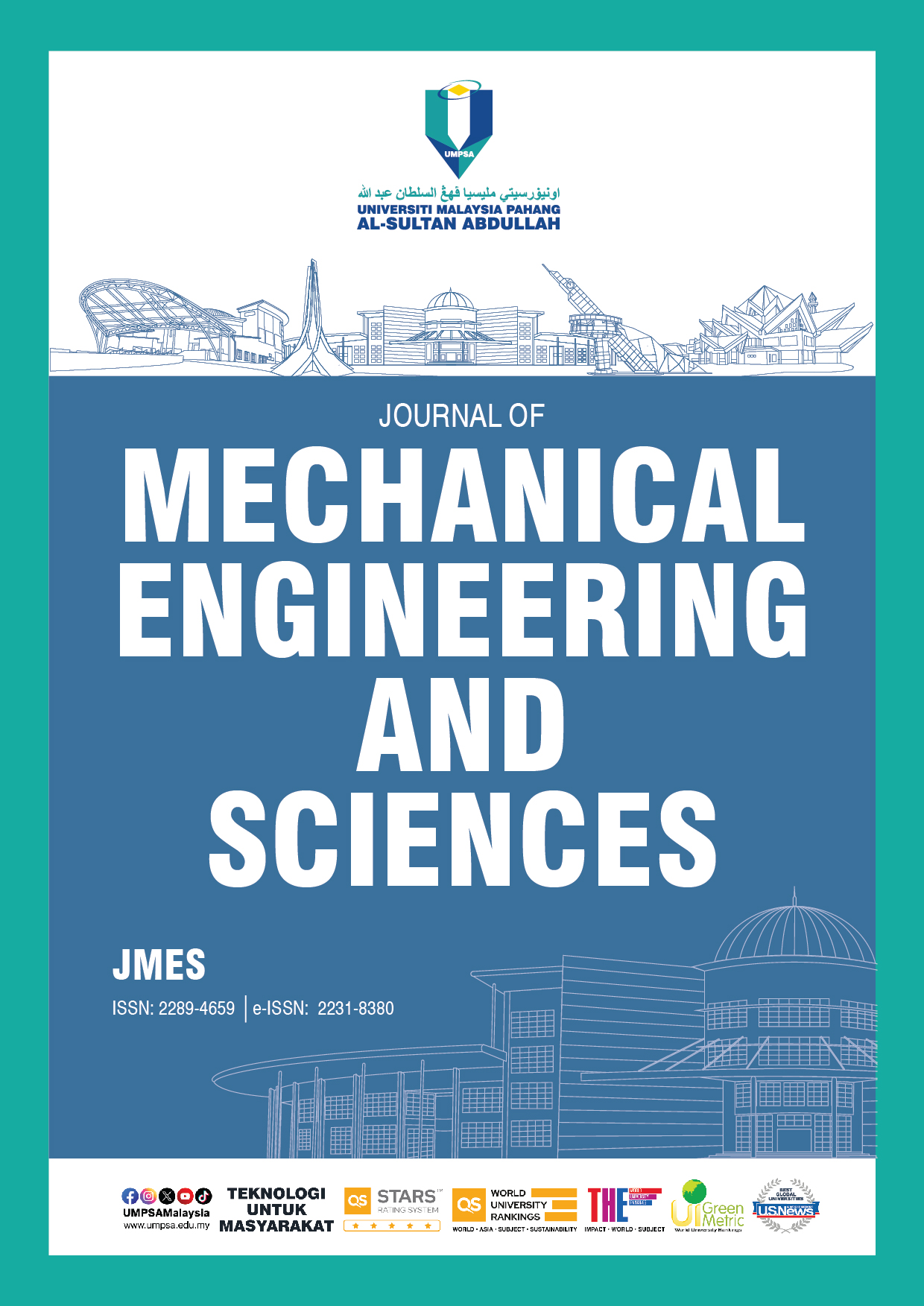Numerical analysis of non-Fourier heat conduction dynamics in the composite layer
DOI:
https://doi.org/10.15282/jmes.17.3.2023.6.0760Keywords:
Non-Fourier conduction, Finite element model, Composite layer, Thermal wave, Relaxation timeAbstract
This paper presents the numerical analysis of non-Fourier heat conduction in thin composite layers under asymmetrical boundary conditions. In the thermal barriers such as steam and gas turbine blades, thin film coating are used to protect the blade from thermal damage. The coating on the blades are very short in length. Heat conduction across thin composite layer with short time is examined using a finite element approach. With this very small duration with the finite speed of the thermal wave, the Fourier mode of heat conduction is disappeared due to the infinite speed of the thermal wave assumption. Therefore, analyzing the non-Fourier heat conduction in thin layers is essential. The developed model is executed in Python using Newmark's scheme and the constant average acceleration method to predict the temperature variation and temperature contours. The present model is validated with an experimental and numerical solution with good agreement. Besides, the temperature distribution across the composite layer with the entire length of the substrate and the coating for different thermal conductivity values, thermal diffusivity, and relaxation time are examined. It is noted that when the dimensionless
References
C. Cattaneo, “Sur une forme de l’equation de la chaleur eliminant la paradoxe d’une propagation instantantee,” Comptes Rendus de l’Académie des Sciences, vol. 247, pp. 431–433, 1958.
P. Vernotte, “Les paradoxes de la theorie continue de l’equation de la chaleur,” Comptes Rendus de l’Académie des Sciences, vol. 246, pp. 3154–3155, 1958.
M. J. Maurer and H. A. Thompson, “Non-Fourier effects at high heat flux,” Journal of Heat and Mass Transfer, vol. 95, no. 2, pp. 284–286, 1973.
M. N. Özişik and B. Vick, “Propagation and reflection of thermal waves in a finite medium,” International Journal of Heat and Mass Transfer, vol. 27, no. 10, pp. 1845–1854, 1984.
K. E. Goodson and M. I. Flik, “Electron and phonon thermal conduction in epitaxial high-Tc superconducting films,” Journal of Heat and Mass Transfer, vol. 115, no. 1, pp. 17–25, 1993.
M. N. O ̈zis ̧ik and D. Y. Tzou, “On the wave theory in heat conduction,” Journal of Heat and Mass Transfer, vol. 116, no. 3, pp. 526–535, 1994.
D. Y. Tzou, Macro‐ to Microscale Heat Transfer –The Langging Behaviour, 2ndEds., John Wiley & Sons Ltd, 2015.
X. Xu, C. P. Grigoropoulos, and R. E. Russo, “Transient temperature during pulsed excimer laser heating of thin polysilicon films obtained by optical reflectivity measurement,” Journal of Heat and Mass Transfer, vol. 117, no. 1, pp. 17–24, 1995.
Z. M. Tan and W. J. Yang, “Non-Fourier heat conduction in a thin film subjected to a sudden temperature change on two sides,” Journal of Non-Equilibrium Thermodynamics, vol. 22, no. 1, p. 75, 1997.
Z. M. Tan and W. J. Yang, “Heat transfer during asymmetrical collision of thermal waves in a thin film,” International Journal of Heat and Mass Transfer, vol. 40, no. 17, pp. 3999–4006, 1997.
L. Wang, “Solution structure of hyperbolic heat-conduction equation,” International Journal of Heat and Mass Transfer, vol. 43, no. 3, pp. 365–373, 2000.
T. K. Cheung, B. A. Blake, and T. T. Lam, “Heating of finite slabs subjected to laser pulse irradiation and convective cooling,” Journal of Thermophysics and Heat Transfer, vol. 21, no. 2, pp. 323–329, 2007.
L. Wang, X. Zhou, and X. Wei, Heat Conduction: Mathematical Models and Analytical Solutions. 1stEd., Springer Berlin, Heidelberg, 2007.
A. Moosaie,“Non-Fourier heat conduction in a finite medium with insulated boundaries and arbitrary initial conditions,” International Communications in Heat and Mass Transfer, vol. 35, no. 1, pp. 103–111, 2008.
M. Lewandowska and L. Malinowski, “An analytical solution of the hyperbolic heat conduction equation for the case of a finite medium symmetrically heated on both sides,” International Communications in Heat and Mass Transfer, vol. 33, no. 1, pp. 61–69, 2006.
L. A. Peterson, T. K. Cheung, T. T. Lam, and B. A. Blake, “Heat conduction in two-dimensional slabs subjected to spatially decaying laser pulses,” Journal of Thermophysics and Heat Transfer, vol. 23, no. 1, pp. 18–27, 2009.
T. T. Lam and E. Fong, “Heat diffusion vs. wave propagation in solidssubjected to exponentially-decaying heat source: Analytical solution,” International Journal of Thermal Sciences, vol. 50, no. 11, pp. 2104–2116, 2011.
E. Fong and T. T. Lam, “Asymmetrical collision of thermal waves in thin films: An analytical solution,” International Journal of Thermal Sciences, vol. 77, pp. 55–65, 2014.
K. Mitra, S. Kumar, A. Vedevarz, and M. K. Moallemi, “Experimental evidence of hyperbolic heat conduction in processed meat,” Journal of Heat and Mass Transfer, vol. 117, no. 3, pp. 568–573, 1995.
W. Kaminski, “Hyperbolic heat conduction equation for materials with a nonhomogeneous inner structure,” Journal of Heat and Mass Transfer, vol. 112, no. 3, pp. 555–560, 1990.
W. Roetzel, N. Putra, and S. K. Das, “Experiment and analysis for non-Fourier conduction in materials with non-homogeneous inner structure,” International Journal of Thermal Sciences, vol. 42, no. 6, pp. 541–552, 2003.
A. L. Koay, S. H. Pulko, and A. J. Wilkinson, “Reverse time TLM modeling of thermal problems described by the hyperbolic heat conduction equation,” Numerical Heat Transfer, Part B: Fundamentals, vol. 44, no. 4, pp. 347–363, 2003.
S. Torii and W.-J. Yang, “Heat transfer mechanisms in thin film with laser heat source,” International Journal of Heat and Mass Transfer, vol. 48, no. 3, pp. 537–544, 2005.
W.-B. Lor and H.-S. Chu, “Hyperbolic heat conduction in thin-film high Tc superconductors with interface thermal resistance,” Cryogenics, vol. 39, no. 9, pp. 739–750, 1999.
W.-B. Lor and H.-S. Chu, “Effect of interface thermal resistance on heat transfer in a composite medium using the thermal wave model,” International Journal of Heat and Mass Transfer, vol. 43, no. 5, pp. 653–663, 2000.
H.-T. Chen and K.-C. Liu, “Study ofhyperbolic heat conduction problem in the film and substrate composite with the interface resistance,” Japanese Journal of Applied Physics, vol. 41, no. 10, pp. 6267–6275, 2002.
J. Li, P. Cheng, G. P. Peterson, and J. Z. Xu, “Rapid transient heat conduction in multilayer materials with pulsed heating boundary,” Numerical Heat Transfer Applications Part A, vol. 47, no. 7, pp. 633–652, 2005.
S. Akwaboa, P. Mensah, E. Beyazouglu, and R. Diwan, “Thermal modeling and analysis of a thermal barrier coating structure using non-Fourier heat conduction,” Journal of Heat and Mass Transfer, vol. 134, no. 11, 2012.
R. Yuvaraj and D. Senthil Kumar, “Numerical simulation of thermal wave propagation and collision in thin film using finite element solution,” Journal of Thermal Analysis and Calorimetry, vol. 142, no. 6, pp. 2351–2369, 2020.
M. Mozafarifard, S. M. Mortazavinejad, and D. Toghraie, “Numerical simulation of fractional non-Fourier heat transfer in thin metal films under short-pulse laser,” International Communications in Heat and Mass Transfer, vol. 115, p. 104607, 2020.
Y. Liu, L. Li, and Y. Zhang, “Numerical simulation of non-Fourier heat conduction in fins by lattice Boltzmann method,” Applied Thermal Engineering, vol. 166, p. 114670, 2020.
R.-Y. Dong, Y. Dong, and A. Sellitto, “An analogy analysis between one-dimensional non-Fourier heat conduction and non-Newtonian flow in nanosystems,” International Journal of Heat and Mass Transfer, vol. 164, p. 120519, 2021.
A. Khosravirad and M. B. Ayani, “Comparative analysis of thermal damage to laser-irradiated breast tumor based on Fourier conduction and non-Fourier heat conduction models: A numerical study,” International Communications in Heat and Mass Transfer, vol. 145, p. 106837, 2023.
J. S. Hu, B. L. Wang, H. Hirakata, and K. F. Wang, “Thermal shock fracture analysis of auxetic honeycomb layer based on non-Fourier heat conduction,” Engineering Structures, vol. 279, p. 115581, 2023.
J. N. Reddy, An Introduction to the Finite Element Method, 3rded., McGraw-Hill Education, 2005.
Downloads
Published
Issue
Section
License
Copyright (c) 2023 Universiti Malaysia Pahang Publishing

This work is licensed under a Creative Commons Attribution-NonCommercial 4.0 International License.






